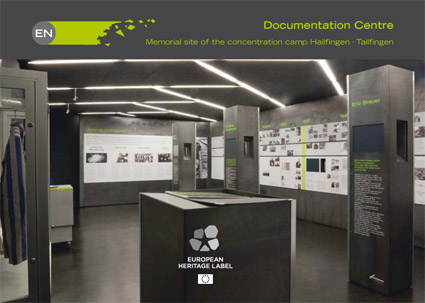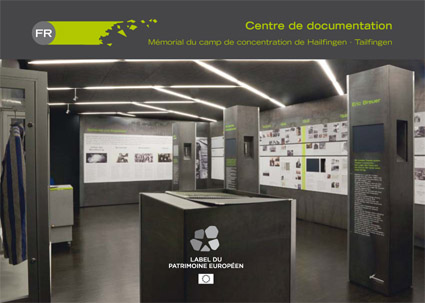The Hailfingen/Tailfingen “work camp”
In 1944, there were plans to expand the Hailfingen airfield so it could be used as a base for night fighters. There was a shortage of German labourers, so between then and the end of World War II, some 2000 prisoners of war, forced labourers, and concentration camp inmates were pressed into service on the construction work.
On November 19, 1944, a transport from the concentration camp Stutthof (near Danzig/Gdansk) brought 601 prisoners to Tailfingen, where the “Hailfingen work camp” was established as a satellite camp to the Natzweiler/Struthof concentration camp in the Alsace region. The authorities asked for the transfer of camp prisoners to build the airstrip for night flyers; a memorial to them now stands on its runway. They worked mainly in the surrounding quarries, laying the runway, and building two taxiways.
The prisoners ranged in age from 14 to 60 and were originally from 16 different countries. Most of them had been in Auschwitz before they arrived here. Many of them lost parents, siblings, or children there. About 50 of the prisoners had been deported directly from the Baltic region.
A hangar, guarded and surrounded by fencing, served as their barracks. The prisoners initially slept on a bare floor covered only with straw. The sanitary facilities were inadequate and there was no medical care. Many prisoners died as a result of the heavy labour, the cold, illness, and malnutrition. A few of the survivors can recall being given food on the way to work by nearby residents.
In mid-February, 1945, the camp was evacuated, and the surviving prisoners were sent to the concentration camps at Vaihingen/Enz, Dautmergen, Allach, and Bergen-Belsen, where many of them later died. There is proof of the death of 189 inmates at Hailfingen itself. Between November 21, 1944 and January 5, 1945, the crematorium at Reutlingen burned the bodies of 99 dead from the camp. And 15 prisoners, who died between December 4 and 9, 1944, were
burned at the crematorium in Esslingen. A mass grave, discovered on June 1, 1945, contained 75 bodies.

Le « camp de travail » de Hailfingen/Tailfingen
En 1944, on décida d’agrandir l’aérodrome de Hailfingen pour l’adapter aux missions des chasseurs nocturnes. Comme la main d’oeuvre allemande manquait, env. 2000 prisonniers de guerre, travailleurs forcés et détenus des camps de concentration furent affectés au chantier jusqu’à la fin de la Seconde Guerre mondiale.
Le 19 novembre 1944, un convoi arriva du camp de concentration de Stutthof, près de Dantzig. Il amenait 601 détenus à Tailfingen, où fut créé le « camp de travail de Hailfingen », annexe du camp de Natzweiler-Struthof (Alsace). Ils devaient agrandir l’aérodrome de chasseurs nocturnes, sur l’ancienne piste duquel un monument commémore aujourd’hui leur souvenir. La plupart furent affectés dans les carrières des environs ou sur les chantiers de la piste de décollage et de deux voies de circulation.
Âgés de 14 à 60 ans, les prisonniers venaient de 16 pays différents. La plupart étaient passés par Auschwitz avant de venir ici. Beaucoup y avaient perdu leurs parents, leurs frères et soeurs ou leurs enfants. Une cinquantaine d’entre eux venaient des pays baltes.
Un hangar surveillé et entouré de barbelés servait de camp. Au début, les détenus dormaient à même le sol sur de la paille. À l’insuffisance des installations sanitaires s’ajoutait l’absence de soins médicaux. Beaucoup sont morts exténués par le travail, le froid, la maladie et la malnutrition. Certains survivants se souviennent que lorsqu’ils allaient au travail, des habitants du voisinage leur donnaient de la nourriture.
À la mi-février 1945, le camp fut évacué et les détenus survivants furent emmenés dans les camps de concentration de Vaihingen/Enz, Dautmergen, Allach et Bergen-Belsen, où beaucoup d’entre eux moururent.
À Hailfingen même, la mort de 189 détenus est documentée : entre le 21 novembre 1944 et le 5 janvier 1945, 99 morts du camp furent brûlés au crématorium de Reutlingen. 15 détenus décédés entre le 4 et le 9 décembre 1944 furent incinérés au crématorium d’Esslingen. Une fosse commune découverte le 1er juin 1945 contenait 75 cadavres.
